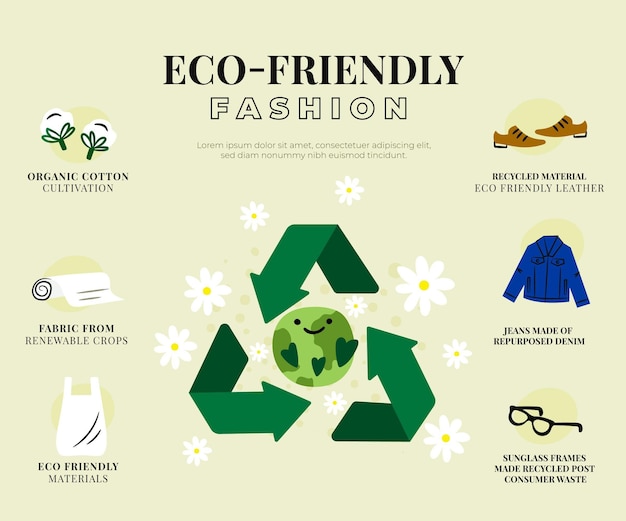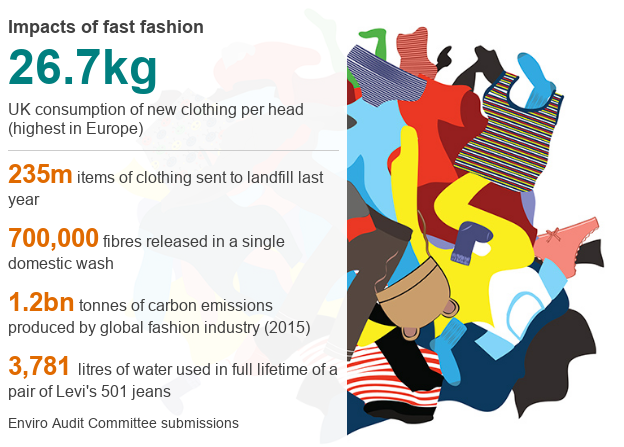Sustainable Fashion
What is Sustainable Fashion?
Sustainable fashion (also known as eco-fashion) is a movement and process of fostering change to fashion products and the fashion system towards greater ecological integrity and social justice. Sustainable fashion concerns more than just addressing fashion textiles or products. It addresses the entire manner in which clothing is produced, who produces it, and how long the life span of a product is before it reaches the landfill. This sustainable movement combats the large carbon footprint that the fashion industry and fast fashion have created by reducing greenhouse gas emissions. Reducing the environmental impact of fashion can combat air pollution, water pollution and overall climate change that could possibly prevent millions of premature deaths over the next century.Ethical fashion, a related term that is also prevalent in the conscious consumerism world, refers to clothing made in ways that value social welfare and worker rights. (Note: For vegans, ethical fashion may also refer to the avoidance of pelts, leather, and animal fibers in the clothes.) Because environmentalism goes hand in hand with socially equitable practices, however, ethical and sustainable fashion are intricately tied together.
In this blog we will talk about why most of fashion is not sustainable today, and then some simple tips you can keep in mind to support a more environmentally friendly fashion industry.
Why most of fashion today is NOT sustainable?
The word sustainable is defined as “capable of being sustained.” Therefore, a sustainable fashion industry is one that must operate in ways that can continue working for years and decades to come. Unfortunately, this is not true of today’s dominant ‘fast fashion,’ which refers to clothing that's intentionally designed to be consumed quickly at cheap prices, leading shoppers to view clothes as being disposable—wearing them just a few times before throwing them out or moving on to newer and trendier cheap clothes. The fast fashion cycle is far from sustainable, because it depletes the Earth’s natural resources at exponential rates, exploits workers around the world, and results in an overwhelming amount of waste. In contrast to traditional fashion houses that only have a few seasonal collections per year, fast fashion brands may churn out as many as one new collection per week (or more) in efforts to drive continuous, mindless consumption.“In contrast to traditional fashion design houses that only have a few seasonal collections per year, fast fashion brands may churn out as many as one new collection every week, in efforts to drive continuous, mindless consumption.”
Shedding light on “The True Cost” of fashion:
Shortly after the factory collapse, a documentary film called The True Cost was released, bringing to light even more information about the devastation caused by the fashion industry. Following these tragic events and a deeper understanding of the industry's true costs, many activists and organizations began tirelessly bringing attention to the problems caused by fast fashion, encouraging both consumers and brands to change their ways and be accountable to the social and environmental impacts of their choices. After all, as Fashionista's Whitney Bauck said in Green Dreamer Podcast episode 129:“Regardless of what your background is, we can all agree on some really basic things—no one should die to make a T-shirt, and we shouldn't be pouring toxins into our planet.”
Hope for a more sustainable future in fashion
With all of the above said, fashion can be made more sustainable in numerous ways—from using organic materials, using biodegradable dyes, to engineering patterns that create zero waste.
The sheer number of different ways to improve the industry, though, means that shopping “more sustainably” can prove to be overwhelming at first, with a multitude of factors to consider.
My recommendation for you is to think about which social or environmental concerns you feel most passionate about and then to first prioritize those focuses as your entry point into sustainable fashion.
The industry is still learning how to best elevate its social and environmental standards, and because the movement is still evolving, it definitely helps for us to focus on continuously doing better, rather than striving for and expecting perfection right now.
In light of this, below are some simple things you can look for to slowly green your wardrobe.
What is Fashion Cycle?
What to look for to support Sustainable Fashion?
Low impact natural and organic materials:
This is because natural fibers are biodegradable and can compost cleanly back into the soil (assuming there are no harmful chemical residues left in the fabric), unlike synthetic fibers that will not biodegrade and instead sit in landfills, continually leaching toxic chemicals and fumes.
That said, some natural materials are more sustainable than others, with hemp, linen, and organic cotton generally being among the most environmentally friendly. Some wools and plant fibers can even be grown in ways that are regenerative, meaning able to regenerate healthy soils and sequester carbon (which helps to combat climate change).
As for cellulose fibers—while they come from plant-based origins, some are extracted from destructive harvesting that aggravate deforestation, while many are made in ways that produce toxic chemical byproducts in the manufacturing phase.
Pro tip: Where possible, keep an eye out for organic certifications (like GOTS) for plant-based fibers and ethical indications and standards for wool, such as ZQ-certified wool.
Also, for cellulosic fabrics, look to prioritize lyocell or Tencel, a branded fiber by Lenzing, which is an industry leader in innovating environmentally conscious fibers.
Recycled or deadstock materials:
Using pre-existing materials to create new clothing is always a great choice because it does not require the extraction of new resources from the Earth but rather makes the most use of materials that may otherwise go to waste.
Pro tip: Look for fabrics made of recycled fibers (e.g., recycled nylon, recycled polyester, recycled cotton), clothes made of up-cycled materials (repurposed fabric), or clothes made from deadstock fabric (materials created, never sold nor used and would otherwise be thrown away).
Eco-friendly dyes and Blue sign or OEKO-TEX certifications:
Whether you're looking at natural fibers or synthetic ones, it's also important to consider the environmental impact of the dyes and textile treatment processes. Many dye and finishing processes involve egregious amounts of water and the use of toxic chemicals.
Pro tip: Eco-friendly dyes include ones from digital printing that require less water, natural, plant-based dyes, and certified nontoxic dyes. You can also look for the Blue sign or OEKO-TEX 100 certifications.
Zero or low waste design:
A lot of waste in the fashion industry comes from cutting out patterns, so some sustainable fashion brands are designing patterns that result in zero wasted material instead.
In addition, brands may strive to minimize the amount of water and energy use from the manufacturing process; reduce waste by eliminating excessive plastic packaging when transporting from the manufacturer, to the warehouse, and to the customer; and/or ship in bulk and using recycled or biodegradable shipping materials.
Pro tip: Look for brands that make it a priority to minimize byproduct waste in their manufacturing process and excessive packaging materials during transport.
Locally made clothes and ones made in renewable energy run facilities:
With all of the dyeing, sewing, and shipping involved, the fashion industry has a high carbon footprint.
Some brands tackle this by making clothing closer to where it will ultimately be sold, rather than having to ship from overseas. Others lower their carbon footprint by installing solar panels and wind turbines to provide renewable power to their offices and factories.
Pro tip: Support local makers that source fibers from the region and ones that produce their clothes in renewable energy powered facilities.

Second hand or durable clothes:
Instead of opting for fast fashion that is cheap and meant to be thrown away quickly, you can be a more sustainable fashion consumer by also responsibly caring for your clothes to prolong their lives or buying secondhand, which keeps clothes out of landfills for longer.
Buying higher quality, more durable clothing that you can envision yourself wearing again and again throughout the years (even if it's a little more expensive) helps as well, as it means that it may last in your wardrobe for longer.
Finally, taking good care of your clothes can make a big, positive difference as well, since much of the environmental impact (e.g., water and energy use) from our clothes’ life-cycles may come from this care-taking stage.
Pro tip: Choose secondhand clothes first, prioritize durable, high quality clothes you know you'll wear throughout the years, wash clothes in cold water, and hang them to dry. Mending holes, spot cleaning stains, and making simple alterations are other ways to keep your clothing out of the landfill for longer.




Comments
Post a Comment